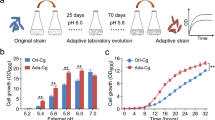Abstract
Over-expression of the gene, mshA, coding for mycothiol glycosyl transferase improved the robustness of Corynebacterium glutamicum to various stresses. Intracellular mycothiol (MSH) content was increased by 114 % in WT(pXMJ19-mshA) compared to WT(pXMJ19). Survival rates increased by 44, 39, 90, 77, 131, 87, 52, 47, 57, 85 and 33 % as compared to WT(pXMJ19) under stress by H2O2 (40 mM), methylglyoxal (5.8 mM), erythromycin (0.08 mg ml−1), streptomycin (0.005 mg ml−1), Cd2+ (0.01 mM), Mn2+ (2 mM), formic acid (0.05 %), acetic acid (0.15 %), levulinic acid (0.25 %), furfural (7.2 mM), and ethanol (10 % v/v), respectively. Increased MSH content also decreased the concentration of reactive oxygen species in the presence of the above stresses. Our results may open a new avenue for enhancing robustness of industrial bacteria for production of commodity chemicals.





Similar content being viewed by others
References
Chandel AK, da Silva SS, Singh OV (2013) Detoxification of lignocellulose hydrolysates: biochemical and metabolic engineering toward white biotechnology. Bioenerg Res 6:388–401
Ibraheem O, Ndimba BK (2013) Molecular adaptation mechanisms employed by ethanologenic bacteria in response to lignocellulose-derived inhibitory compounds. World J Microbiol Biotechnol 9:598–612
Lee JY, Seo J, Kim ES, Lee HS, Kim P (2013) Adaptive evolution of Corynebacterium glutamicum resistant to oxidative stress and its global gene expression profiling. Biotechnol Lett 35:709–717
Liu YB, Long MX, Yin YJ, Si MR, Zhang L, Lu ZQ, Wang Y, Shen XH (2013) Physiological roles of mycothiol in detoxification and tolerance to multiple poisonous chemicals in Corynebacterium glutamicum. Arch Microbiol 195:419–429
Mols M, Abee T (2011) Primary and secondary oxidative stress in Bacillus. Environ Microbiol 13:1387–1394
Monnappa AK, Lee JH, Mitchell RJ (2013) Detection of furfural and 5-hydroxymethylfurfural with a yhcN:luxCDABE bioreporter strain. Int J Hydrogen Energ 38:15738–15743
Nanda S, Mohammad J, Reddy SN, Kozinski JA, Dalai AK (2013) Pathways of lignocellulosic biomass conversion to renewable fuels. Biomass Conv Bioref. doi:10.1007/s13399-013-0097-z
Newton GL, Buchmeier N, Fahey RC (2008) Biosynthesis and functions of mycothiol, the unique protective thiol of Actinobacteria. Microbiol Mol Biol Rev 72:471–494
Nicolaou SA, Gaida SM, Papoutsakis ET (2010) A comparative view of metabolite and substrate stress and tolerance in microbial bioprocessing: from biofuels and chemicals, to biocatalysis and bioremediation. Metab Eng 12:307–331
Saharan RK, Kanwal S, Sharma SC (2010) Role of glutathione in ethanol stress tolerance in yeast Pachysolen tannophilus. Biochem Biophys Res Commun 397:307–310
Sakai S, Tsuchida Y, Nakamoto H, Okino S, Ichihashi O, Kawaguchi H, Watanabe T, Inui M, Yukawa H (2007) Effect of lignocellulose-derived inhibitors on growth of and ethanol production by growth-arrested Corynebacterium glutamicum R. Appl Environ Microbiol 73:2349–2353
Shen XH, Jiang CY, Huang Y, Liu ZP, Liu SJ (2005) Functional identification of novel genes involved in the glutathione-independent gentisate pathway in Corynebacterium glutamicum. Appl Environ Microbiol 71:3442–3452
Tauch A, Kirchner O, Löffler B, Götker S, Pühler A, Kalinowski J (2002) Efficient electrotransformation of Corynebacterium diphtheriae with a mini-replicon derived from the Corynebacterium glutamicum plasmid pGA1. Curr Microbiol 45:362–367
Vega NM, Allison KR, Samuels AN, Klempnerd MS, Collinsa JJ (2013) Salmonella typhimurium intercepts Escherichia coli signaling to enhance antibiotic tolerance. Proc Natl Acad Sci USA 110:14420–14425
Yin YJ, Wang BJ, Jiang CY, Luo YM, Jin JH, Liu SJ (2010) Identification and quantification of mycothiol in Actinobacteria by a novel enzymatic method. Appl Microbiol Biotechnol 88:1393–1401
Zhang Y, Li Y (2013) Engineering the anti-oxidative properties of lactic acid bacteria for improving its robustness. Curr Opin Biotechnol 24:142–147
Acknowledgments
This work was supported by the National High Technology Research and Development Program of China (863 program, grant 2013AA102802), National Natural Science Foundation of China (Nos. 31170121 and 31270078) and the Opening Project of State Key Laboratory of Microbial Resource, Institute of Microbiology, Chinese Academy of Sciences (No. SKLMR-20120601).
Author information
Authors and Affiliations
Corresponding author
Electronic supplementary material
Below is the link to the electronic supplementary material.
Rights and permissions
About this article
Cite this article
Liu, YB., Chen, C., Chaudhry, M.T. et al. Enhancing Corynebacterium glutamicum robustness by over-expressing a gene, mshA, for mycothiol glycosyltransferase. Biotechnol Lett 36, 1453–1459 (2014). https://doi.org/10.1007/s10529-014-1501-x
Received:
Accepted:
Published:
Issue Date:
DOI: https://doi.org/10.1007/s10529-014-1501-x




